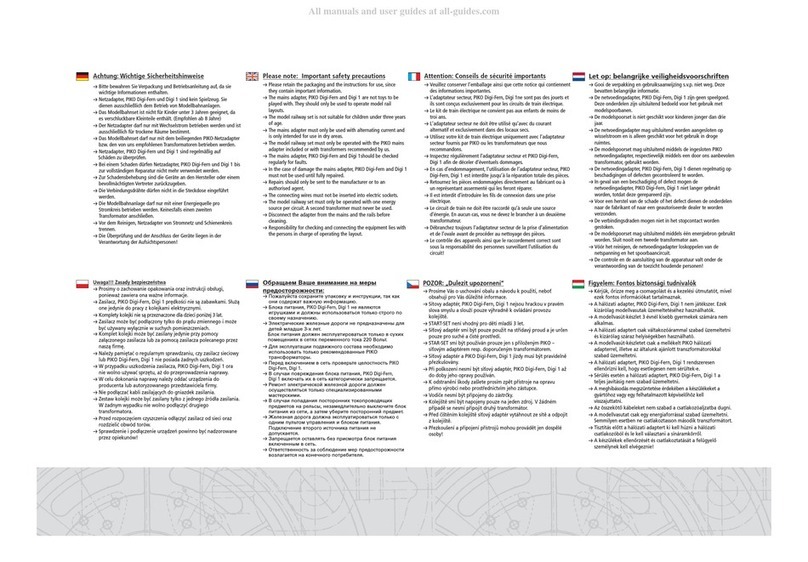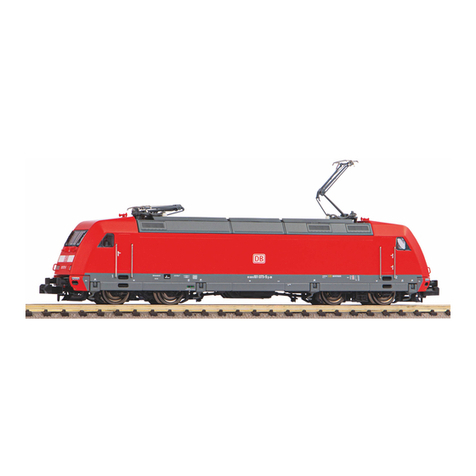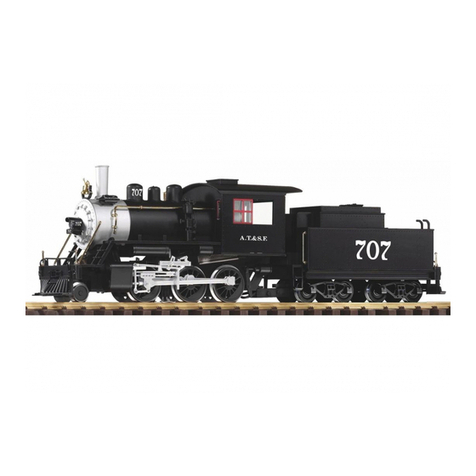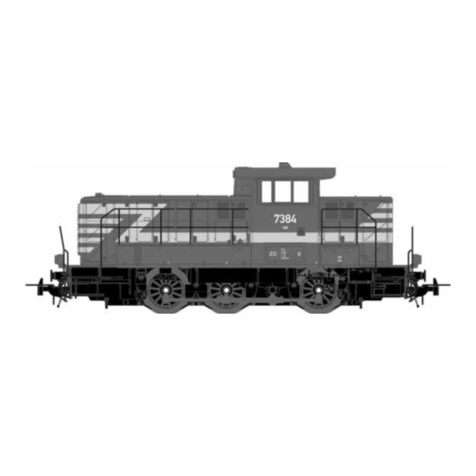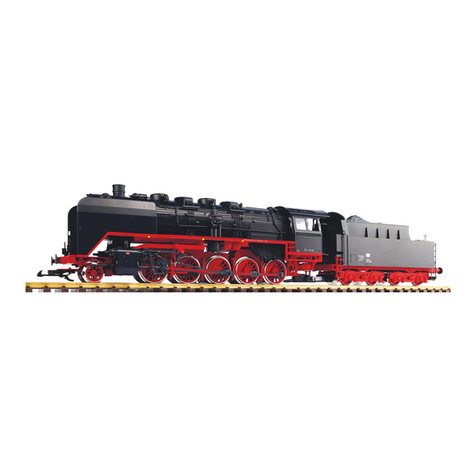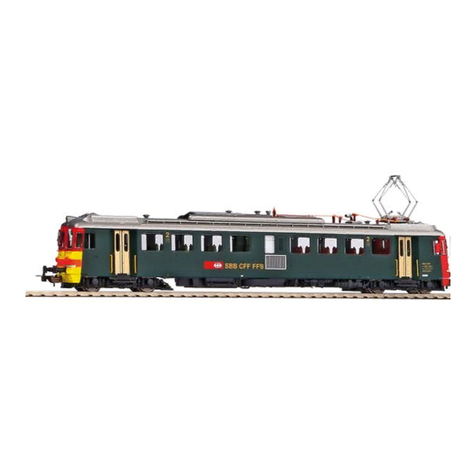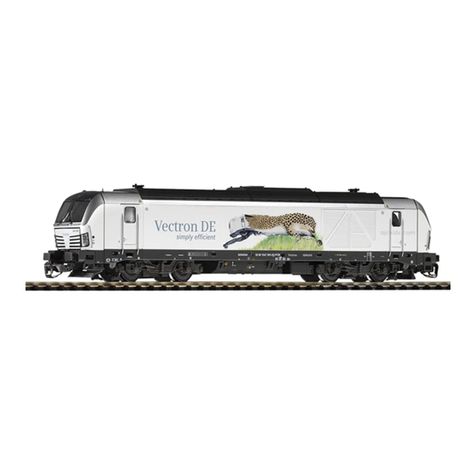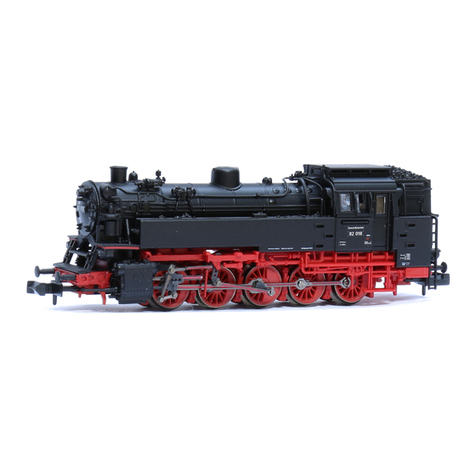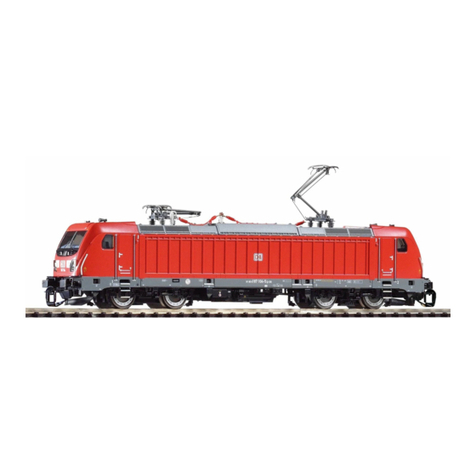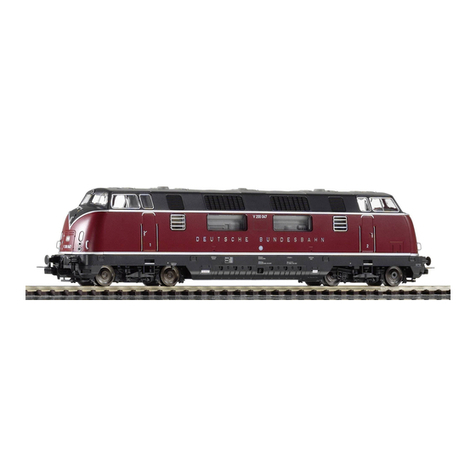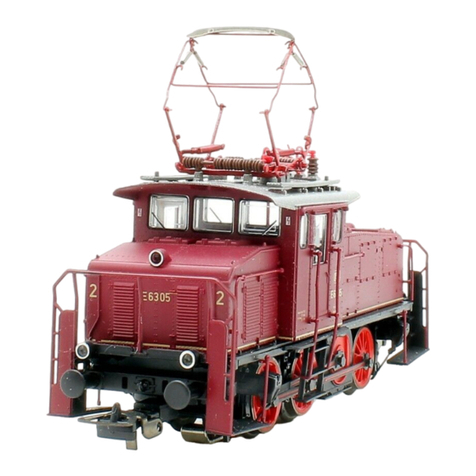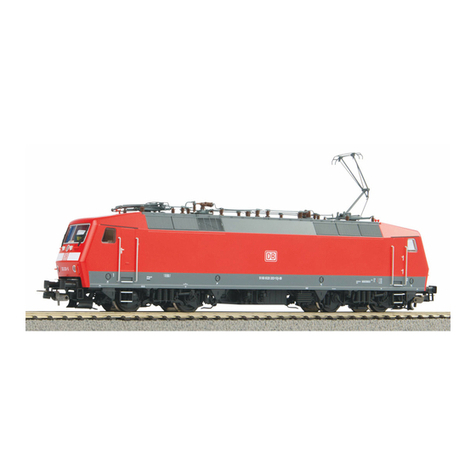
Technische Angaben
Nennspannung
Das Modell wird innerhalb eines
Spannungsbereiches von 0 bis 24 V
betrieben.
Stromversorgung
Die Lokomotive benötigt Trafos oder
Fahrregler, welche min. 2 A und max. 5
A liefern. Verwenden Sie nur zugelassene
und einwandfrei arbeitende Trafos und
Fahrregler.
Antrieb
Das Modell besitzt zwei durchzugskräftige
7-polige, kugelgelagerte Bühlermotore,
welche über ein robustes Getriebe vier
Achsen antreiben.
Beleuchtung
Funktionsfähiges Spitzensignal mittels
LEDs, mit der Fahrtrichtung wechselnd.
Triebwerksbeleuchtung mittels
Funktionstaste oder Schalter schaltbar.
Empfehlungen
Entnahme des Modells
Entnehmen Sie das Modell bitte vorsichtig
aus der Styroporverpackung, damit die
Anbauteile wie Handstangen usw. nicht
beschädigt werden.
Erstbetrieb Ihrer Lok
Wir empfehlen, die Lok jeweils ca. 30 min
je Fahrtrichtung ohne Belastung einfahren
zu lassen, damit das Modell einen
optimalen Rundlauf und eine gute Zugkraft
erhält.
Bitte beachten Sie, dass der einwandfreie
Lauf der Lok nur mit sauberen Schienen
und Rädern gewährleistet ist.
Minimaler Radius
Die Lok kann auf Gleisen mit einem Radius
von 600 mm (23.62‘’) fahren. Aufgrund der
Bauart empfiehlt sich dennoch ein
Mindestradius von 920 mm (36.28“).
Bitte beachten Sie, dass ein längerer
Betrieb auf Kurven mit kleineren Radien zu
einem stark erhöhten Verschleiß der Loko-
motive und der Schienen führt.
Befahren von Weichen
Durch Justieren der Federspannung am
Vorläufer kann ein Aufschneiden von
Weichen verbessert werden. Dadurch ist
es jedoch möglich, dass sich die Kontak-
tierung der Antriebsräder mit dem Gleis
verschlechtert. Generell empfiehlt es sich
Weichen stets korrekt zu schalten.
Geschwindigkeit der Lok
Durch die großen Räder besitzt die
BR 95 einen hohen Schwerpunkt und
kann so bei kleinen Radien und hohen
Geschwindigkeiten schnell entgleisen
oder umkippen. Wir empfehlen deshalb,
die Fahrweise der Lok dem Vorbild
entsprechend anzupassen.
Inbetriebnahme des Dampf-Entwicklers
Benutzen Sie das PIKO Dampf-Destillat.
Füllen Sie nur etwa 10 bis 20 Tropfen
davon in den Schornstein. Achtung! Wenn
zu viel Destillat eingefüllt ist, arbeitet der
Dampf-Entwickler nicht! Überschüssiges
Destillat durch Umdrehen der Lok
ausschütten. Das Heizelement des Dampf-
Entwicklers ist sehr empfindlich, führen Sie
deshalb auf keinen Fall Fremdkörper in den
Schlot ein. Ein Fahren ohne Dampfdestillat
oder verbleibende Reste von Destillat im
Dampf-Entwickler schaden diesem nicht.
Digital Decoder
Das Modell ist werkseitig mit dem
PIKO Lok-Decoder #36125 ausgerüstet.
Die Lok kann sowohl auf digitalen als auch
analogen Anlagen eingesetzt werden.
Sound
Das Modell ist werkseitig mit dem
Sound-Modul #36228 ausgerüstet.
Das Soundmodul beinhaltet einen
Breitbandlautsprecher mit einer
wasserfesten Membrane. Dieser Sound ist
sowohl analog als auch digital verwendbar.
Wartung/Pflege
Schmieren
Bitte geben Sie nach ca. 25 Betriebs-
stunden nach Lösen der Getriebeböden
jeweils eine kleine erbsengroße Menge
säurefreies und harzfreies Fett (PIKO
Schmierfett, Art.-Nr. 36216) auf die
Zahnräder. (siehe Schmierplan, Montage-
anleitung).
Alle beweglichen Teile z. B. Steuerung,
Kardanwelle, Radsätze sollten mit
Feinmechanikeröl vorsichtig abgeölt
werden.
Reinigen
Reinigen Sie die Lok nach längerem
Gartenaufenthalt mit einem milden
Reinigungsmittel und einem fusselfreien
Microfasertuch oder einem weichen Pinsel.
Tauchen Sie auf keinen Fall die komplette
Lok zum Reinigen in eine Lösung.
#35268 Gleisschaltmagnet
In der Lok befindet sich ein entsprechender
Sensor (Reedkontakt), der auf jeden
Gleisschaltmagneten #35268 reagiert und
wahlweise Pfeife oder Glocke auslöst.
Verschleißteile
Schienenschleifer und Radsatzkontakte sind
Verschleißteile! Diese sollten bei Abnutzung
getauscht werden!
Achtung!
Bitte beachten Sie, dass bedingt durch
den Fahrbetrieb ein Abrieb an den
mechanischen Teilen (Räder, Schleifer
usw.) entstehen kann, welcher
Verunreinigungen auf Teppichen oder
anderen Materialien entstehen lässt.
Austretendes Fett/Öl mit einem Tuch
abwischen. Bei Schäden übernimmt
die PIKO Spielwaren GmbH keinerlei
Haftung.
Achtung: Wichtige Sicherheitshinweise
• Transformator regelmäßig auf Schäden
an Kabeln, Steckern, Gehäuse und
anderen Teilen überprüfen!
• Bei einem Schaden darf der
Transformator bis zur vollständigen
Reparatur nicht mehr verwendet werden!
• Lokomotive an nicht mehr als eine
Energiequelle anschließen!
• Kein Spielzeug. Nicht für Kinder unter
14 Jahren geeignet wegen funktions-
und modellbedingter scharfer Kanten
und Spitzen.
• Lokomotive nur mit einem zugelassenen
Transformator mit Kennzeichnung
betreiben!
• Der Transformator ist kein Spielzeug!
• Vor der Reinigung, die Lok vom
Transformator trennen!
• Drähte nicht in die Steckdose einführen!
3

